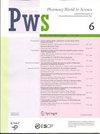POLYPHENOL COMPOSITION OF THE FRUIT AND STEM OF ELDERFLOWER WILD-GROWING IN GEORGIA
引用次数: 1
Abstract
Extending the range of medicinal products produced from plant raw materials and great interest in herbal medicine are totally linked to the availability of plant raw materials, minor toxicity and side effects. The use of medicinal plant raw materials as a source of valuable biologically active substances in the pharmaceutical and food industries is relevant.The aim of the study was to quantify and evaluate antioxidant activity of biologically active compounds (total phenols, anthocyanins) in the fruit and stem of elderflower (Sambucis nigra) and fruits of Caucasian bilberry (Vaccinium artostaphyion) wild-growing in Georgia.As raw material under study, we used wild-growing elderflower fruit with the fruit-bearing stem and bilberry fruits collected in August 2020 in the mountainous region of Georgia (Racha-Lechkhumi) in the phase of full ripeness.It has been confirmed that the elderflower’s fruit stems, as well as the fruit of elderflower anise and bilberry are rich in: phenolic compounds (elderflower’s fruit -13.8 mg/g, stem - 9.2 mg/g; bilberry fruit - 24.9 mg/g); anthocyanins (elderflower’s fruit - 1.4 mg / g, stem - 3.68 mg/g; bilberry fruit - 18.03 mg /g); they are characterized by high antioxidant activity (elderflower’s fruit - 48.2%, stem - 40.5%; bilberry fruit - 60.3%). Based on the results obtained, the fruits of bilberry and elderflower can be considered to be a cheap alternative source of natural antioxidants for the pharmaceutical, cosmetic and food industries.格鲁吉亚野生接骨木花果实和茎的多酚成分
从植物原料生产的药品范围的扩大和对草药的极大兴趣完全与植物原料的可用性、毒性和副作用小有关。药用植物原料在制药和食品工业中作为有价值的生物活性物质的来源是相关的。本研究的目的是量化和评价格鲁吉亚野生接骨木花(Sambucis nigra)和高加索越橘(Vaccinium artostaphyion)果实和茎中的生物活性化合物(总酚、花青素)的抗氧化活性。作为研究的原料,我们使用了2020年8月在格鲁吉亚山区(Racha-Lechkhumi)采集的成熟的野生接骨木花果实和结果的蔓越莓果实。经证实,接骨木花的果茎,以及接骨木花八角和越桔的果实都含有丰富的酚类化合物(接骨木花的果实-13.8 mg/g,茎- 9.2 mg/g;越橘果- 24.9毫克/克);花青素(接骨木果实- 1.4毫克/克,茎- 3.68毫克/克;越橘果- 18.03毫克/克);它们的特点是抗氧化活性高(接骨木花果实- 48.2%,茎- 40.5%;越橘果- 60.3%)。根据所获得的结果,越桔和接骨木花的果实可以被认为是一种廉价的天然抗氧化剂的替代来源,用于制药,化妆品和食品工业。
本文章由计算机程序翻译,如有差异,请以英文原文为准。
求助全文
约1分钟内获得全文
求助全文

 求助内容:
求助内容: 应助结果提醒方式:
应助结果提醒方式:


